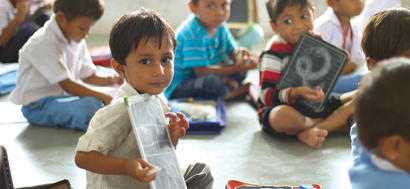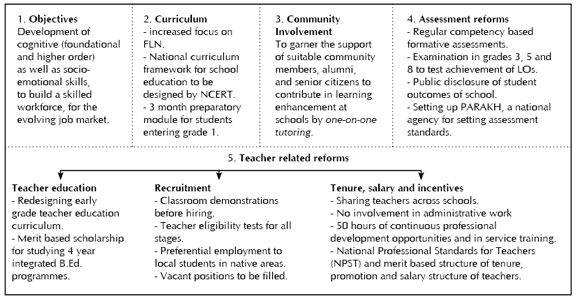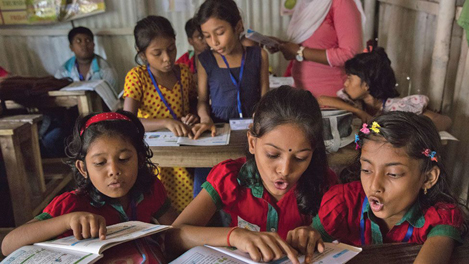Anjali Sharma
Learning Outcomes (LO) are assessment standards that indicate expected levels of learning serving as checkpoints of students’ achievement in their learning trajectory. A frequency tabulation of the National Education Policy 2020 reveals that, in the 60-page document, the word “outcomes” appears 38 times, i.e., roughly on every second page. The policy endorses the discourse on learning outcomes which points to its firm grip on the current education system. The article tries to analyze the policy with reference to the debates on learning outcomes.
History of the discourse on learning outcomes
Nationally…
“Learning Outcomes” as a phrase wasn’t used in policy documents prior to 2000. The Kothari Commission Report, 1966, mentioned outcomes in a broad sense, such as to help society create democratic and aware citizens, which is similar to an educational aim. The National Education Policy, 1968 stated that assessing students shouldn’t be for the purpose of certifying learners’ performance at a given time, rather it should be an evaluation of their level of achievement to enable improvement. Here, level of achievement, interpreted as an outcome wasn’t detailed further. And the 1986 education policy talked about the infamous Minimum Levels of Learning which became the focus of teaching-learning in schools (Kaushik, 2018).
In 2014 the NCERT developed a “Learning Indicators and Learning Outcomes at the Elementary Level” document listing class-wise learning indicators and stage-wise curricular expectations up to class VIII.
In February 2017, an amendment in the Right to Education Act, 2009, mandated all states to prepare class-wise and subject-wise outcomes (Kaushik, 2018). In April 2017, NCERT rolled out “Learning Outcomes at the Elementary Stage” listing expected LOs developed class-wise (from I to VIII) for various subjects to ensure learning and provide quality education (NCERT, 2017).

Finally, the 2020 education policy commits to an outcomes-based discourse.
The Annual Status of Education Report (ASER) is often cited to back the assertion of falling learning levels. This report, since its first issue in 2005-06, brought the ‘outcomes debates’ in public discourse, in India (Kaushik, 2018). The low learning levels that it presents furthers the claim of an ongoing learning crisis thereby establishing the ground for an outcomes-based discourse.
The NCERT has been conducting National Achievement Surveys (NAS) since 2001, every three years, to measure learning achievement of children at different stages, to understand how positively inputs have affected the education system (NCERT, 2012). The data is collected through a standardized test administered to a sample of students. The 2017 NAS focused on learning outcomes.
ASER and NAS are the most referred, others like Sarva Shiksha Abhiyan-Joint Review Mission Reports undertaken by NCERT and National Institute of Educational Planning and Administration, Global Monitoring Report jointly published by the World Bank and the International Monetary Fund also point to the low learning levels.
Globally…
Post the 1990 Jomtien Conference, the developing countries were asked to amend primary education so that the First World could get better labour. For a good decade and longer, the focus was on getting children to school as India gave primacy to “increasing access and ensuring equity (Kaushik, 2018, p. 27).”
In 2000, an Education for All Assessment (EFA) was administered to assess performance of countries on the EFA indicators. The indicator “Improvement in student achievement or learning outcome” was found unsatisfactory.
The Dakar framework of Action, published by UNESCO and adopted by the World Education Forum listed, “Improving every aspect of the quality of education, and ensuring their excellence so that recognized and measurable learning outcomes are achieved by all, especially in literacy, numeracy and essential life skills (p. 17)” as a goal. This marks the shift in expectations from access to outcomes.
In 1997, the Organization for Economic Cooperation and Development (OECD) launched the Programme for International Student Assessment (PISA), first administered in 2000. Every three years, release of the PISA rankings makes headlines worldwide (Gorur, 2016).
Globally, organizations like the World Education Forum (UNESCO, World Bank, Asian Development Bank) and the OECD have been instrumental in triggering the outcomes discourse.
Outcomes: Identification and achievement
The policy says various surveys indicate that India is undergoing a learning crisis with over five crore elementary school children lacking foundational literacy and numeracy (FLN) defined as “…the ability to read and comprehend basic text and the ability to carry out basic addition and subtraction with Indian numerals (p. 8).” The insistence on FLN is supported by submission of a changing economic landscape, with a shift from physical labour to tasks dependent on cognitive skills.
The absence of FLN skills is conceptualized as a lack because low literacy proficiency indicates poor preparedness for the labour market, further education and on-the-job training (World Bank, 2017).
Therefore, to tackle the learning crisis, the policy aims for universal FLN by 2025 and lists pathways for its realization which have been categorized and presented as shown in the figure below.

Analysis
Imagination of learner and political economy: The policy mentions that education aims at producing engaged, productive and contributing citizens via character building and creation of well rounded individuals with 21st century skills, along with cognitive development. Here, the policy’s expectations of children – to be productive, in terms of contributing to the economy reveals that the most important 21st century skill is acquiring FLN to become ‘educable’ and ‘employable’ clearly dwelling on the economics of education perspective, where learning aims at making an individual “employable” and thereby productive.
The policy has an economic leaning as it aims to make children productive citizens in a rapidly modernizing market. The requirement of FLN for employment stems from the assumption that low literacy proficiency leads to job-skill problems (Filmer and Rogers, 2018). It seems to create a jack of all trades, lacking specialization, as the current market prizes multitasking to maximize profit. It assumes the system will have jobs for the skilled, which is naive considering nose-diving vacancies even in the public sector.
This reveals the policy’s unsaid support to a shift in economy from traditional markets relying on physical labour to modern markets based on cognitive and socio-emotional skills and also towards the existing hierarchy between physical and mental labour.
Outcomes-based assessment, imagination of teacher and public disclosure: The policy talks of employing assessment of learners firmly to monitor the achievement of LOs, and meekly for its diagnostic purpose. This brings outcomes into focus pushing learning to the periphery. Overemphasis on testing and consequently the dominance of the textbook culture is part of our colonial legacy (Kumar, 1992). So, a test of FLN, at the end of grade 3 which links students’ performance to a teacher’s salary and promotion is likely to ensure predominant delivery of only reading, writing and arithmetic in classrooms. In such cases, outcomes often become the maximum children learn as assessment surveys test outcome-achievement.
The policy recognizes the principal role of the teacher for achieving desired LOs and makes several recommendations – from recruitment, incentives, to setting up the National Professional Standards for Teachers, to providing standards for a teacher’s role and performance appraisal at different stages and competencies required. The use of incentives and test results to hold teachers accountable and push them to do their job correctly elucidates the policy’s imagination of the teacher as an individual devoid of motivation to teach which is paradoxical as it seeks to empower them. How can constant pressure to deliver outcomes empower anybody? This system of performance-based incentives also originates from the colonial education system, where students’ performance determined a teacher’s salary.

It mandates public disclosure of standardized-test results, maintaining students’ anonymity, stating it will enable stakeholders to make informed choices and increase accountability on the part of the school. A system which predominantly uses assessment to monitor will deepen competition among schools to do well on standardized tests. The examination system works to normalize a gaze of judgment, surveillance, classification and punishment (Foucault, 1977) and achievement tests also seem to monitor and classify schools and by extension teachers, based on students’ performance.
One may question what is wrong with setting standards? India has a multi-layered school system with differential access to resources. Standards become unessential as they demand homogenization in achievement which is unfair as resources aren’t equally distributed.
The policy mirrors the 2017 World Bank Report – “The Many Faces of the Learning Crisis” in aspects of evidence cited, claims made, goals aimed at and solutions put forward. The complication is international organizations often propagate a Global North understanding. These ideas don’t apply just the same to children and countries in the Global South because of the obvious differences. If one believes outcome-driven surveys and public disclosure will help tackle the said learning crisis, then such surveys going on for decades would’ve done their job. The idea of a universal FLN is welcome but the pathway of implementation and desired ends are problematic and require rethinking.
In substance, the policy adopts an instrumentalist view, reducing education to a tool for economic gains, both individual and collective. The overwhelming focus on FLN and its testing, that has been the scope of this paper, divulges the following assumptions – one, outcomes have been prioritized over inputs. Two, “…we do not measure what we value, we come to value what we measure (Gorur, 2016, p. 602)” indicates FLN has been prioritized as it can be measured and since it’s measured and recorded, it’s valued over other skills. Three, the imagination of learning is largely behaviouristic. Four, outcomes have become a parameter for quality. Five, Gorur (2016) noted that PISA tests place “competition, standardization, test-based accountability, and school choice” over “collaboration, personalisation, trust-based professionalism and equity of outcomes (p. 602)” which is largely what this policy also seems to be doing. By subscribing to an outcomes-based discourse, it chooses from either of the options, making it a political selection.
References
- Filmer, D. & Rogers, H. (2018). Learning to realise education’s promise. Seminar Issue 706.
- Foucault, M. (1977). Discipline and Punish: The Birth of the Prison. Vintage Books.
- Global Education Monitoring Report. (2014). The Jomtien Conference in 1990 was a game changer in education. Retrieved from https://gemreportunesco.wordpress.com/2014/08/22/the-jomtien-conference-in-1990-was-a-game-changer-for-education/
- Gorur, R. (2016). Seeing like PISA: A cautionary tale about the performativity of internal assessments. European Educational Research Journal, 15(5). Sage Publications.
- https://www.education.gov.in/sites/upload_files/mhrd/files/Learning_outcomes.pdf
- Kaushik, A. (2018). Measuring Learning Outcomes in India. Seminar Issue 706.
- Kumar, K. (1992). What is Worth Teaching? Orient Longman.
- MHRD (Now Ministry of Education). (2020). National Education Policy 2020. MHRD.
- UNESCO (2000). Dakar Framework for Action: Education for All. Meeting Our Collective Commitments. World Forum on Education, Dakar, Senegal, 26-28 April 2000, UNESCO, Paris.
- World Bank. (2017). Learning to realise education’s promise: The many faces of the learning crisis. World Bank.
The author is a trained educator and has recently completed her master’s in education. Her interest areas are policy, curriculum and language pedagogy. She can be reached at anjali.sharma2021.as@gmail.com.
